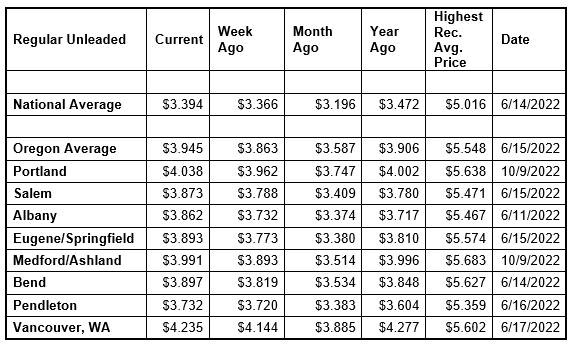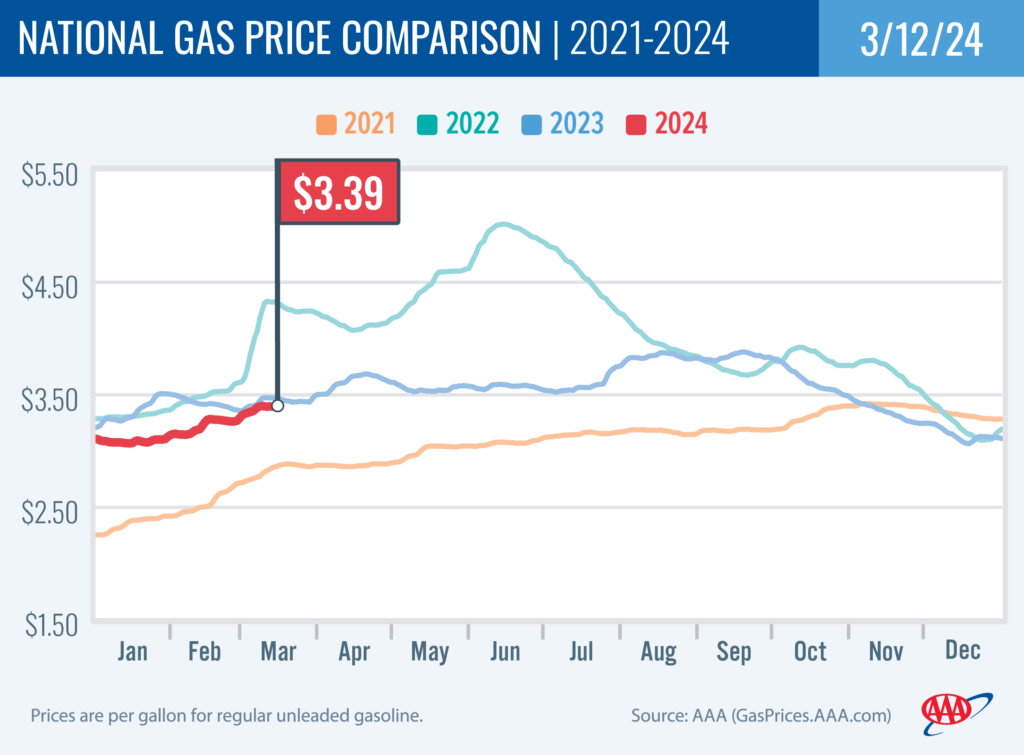PORTLAND, Ore., – Pump prices continue their steady march higher across the country due to the seasonal factors of refinery maintenance, the switch to summer-blend fuel, and increased demand for gas. Here in the Pacific Northwest, the closure of locks on the Columbia River has also put upward pressure on pump prices because fuel barges have not been able to travel on the river which has caused some tight supplies. For the week, the national average for regular adds three cents to $3.39 a gallon. The Oregon average gains eight cents to $3.95 a gallon.

“Gas prices continue to climb, but the rate of increase is slowing down a little in some areas. Part of that is due to a higher refinery utilization rate, meaning refineries have been increasing production of fuel. This time of year is always a balancing act between refinery maintenance, the switch to summer-blend fuel, and the increasing demand for gas that we normally see this time of year,” says Marie Dodds, public affairs director for AAA Oregon/Idaho. “Demand for gas normally rises in the late winter and early spring, especially after the switch to Daylight Saving time.”
Maintenance on the locks along the Columbia River in the Pacific Northwest has been one of the reasons for tighter gasoline supplies in the area. Wholesale prices shot up and those increase are being passed on to consumers in higher retail prices. Some of the locks are expected to reopen March 16 and others by the end of the month.
This is the time of year for the seasonal climb in gas prices due to refinery maintenance and the switch to EPA-mandated summer-blend fuel. California switches earlier than other states, and as a result, supplies have tightened in the West Coast region. The Gulf Coast has now switched to summer-blend fuel, and prices in that area have increased in the last few days.
Several Oregon counties again have averages above $4 a gallon:
Columbia $4.04
Coos $4.06
Curry $4.17
Lake $4.06
Harney $4.07
Josephine $4.05
Multnomah $4.11
Tillamook $4.03
Wasco $4.06
The Oregon average began 2024 at $3.79 a gallon compared to $3.95 today. The national average started the year at $3.11 and is at $3.39 today.
Gas prices normally rise in the first and second quarters of the year. The factors include refinery maintenance season, the normal seasonal growth in demand, and the federally mandated switch from winter-blend fuel to summer-blend, which is more expensive to produce. Summer-blend gas helps reduce emissions from gasoline during the warm summer months. More info on summer- and winter-blend gasoline can be found at the EPA website.
Crude oil prices remain in the upper $70s this week. West Texas Intermediate climbed to $79.97 on March 1, which is the highest price in the last month. Prices ticked lower last week in part due to lackluster demand in China.
Crude prices were volatile after the attack on Israel by Hamas in October, but have been relatively steady in the last month. While Israel and the Palestinian territory are not oil producers, there’ve been concerns that the conflict could spread in the Middle East, which could potentially impact crude production in other oil-producing nations in the region.
Crude oil is trading around $78 today compared to $78 a week ago and $75 a year ago. In 2023, West Texas Intermediate ranged between $63 and $95 per barrel. Crude reached recent highs of $123.70 on March 8, 2022, shortly after the Russian invasion of Ukraine, and $122.11 per barrel on June 8, 2022. The all-time high for WTI crude oil is $147.27 in July 2008.
Crude oil is the main ingredient in gasoline and diesel, so pump prices are impacted by crude prices on the global markets. On average, about 57% of what we pay for in a gallon of gasoline is for the price of crude oil, 11% is refining, 16% distribution and marketing, and 17% are taxes, according to the U.S. Energy Information Administration.
Demand for gas in the U.S. jumped from 8.47 to 9.01 million b/d for the week ending March 1, according to the U.S. Energy Information Administration (EIA). This compares to 8.56 million b/d at the same time last year. Meanwhile, total domestic gasoline stocks tightened by 4.5 million bbl to 239.7 million bbl.
Growing gas demand, amid tighter supply, has pushed pump prices higher.
Quick stats
Oregon is one of 39 states and the District of Columbia with higher prices now than a week ago. Missouri (+16 cents) has the largest week-over-week gain in the nation. Oregon has the 12th-largest increase. Indiana (-10 cent) has the biggest weekly decline. The average in Hawaii is flat.
California ($4.88) has the most expensive gas in the nation for the second week in a row. Hawaii ($4.71) is second, Washington ($4.21) is third and Nevada ($4.12) is fourth. These are the only four states with averages at or above $4, same as a week ago. This week 44 states and the District of Columbia have averages in the $3-range. Two states have averages in the $2 range this week.
The cheapest gas in the nation is in Mississippi ($2.94) and Texas ($2.98). No state has had an average below $2 a gallon since January 7, 2021, when Mississippi and Texas were below that threshold.
The difference between the most expensive and least expensive states is $1.94 this week, same as a week ago.
Oregon is one of 49 states and the District of Columbia with higher prices now than a month ago. The national average is 20 cents more and the Oregon average is 34 cents more than a month ago. This is the 11th largest monthly gain in the nation. Montana (+43 cents) has the largest monthly increase.
Oregon is one of eight states and the District of Columbia with higher prices now than a year ago. The national average is eight cents less and the Oregon average is four cents more than a year ago. Colorado (-89 cents) has the largest yearly decrease. Missouri (+14 cents) has the largest year-over-year increase.
West Coast
The West Coast region continues to have the most expensive pump prices in the nation with all seven states in the top 10. It’s typical for the West Coast to have six or seven states in the top 10 as this region tends to consistently have fairly tight supplies, consuming about as much gasoline as is produced. In addition, this region is located relatively far from parts of the country where oil drilling, production and refining occurs, so transportation costs are higher. And environmental programs in this region add to the cost of production, storage and distribution.
| Rank | Region | Price on 3/12/2024 |
| 1 | California | $4.88 |
| 2 | Hawaii | $4.71 |
| 3 | Washington | $4.21 |
| 4 | Nevada | $4.12 |
| 5 | Oregon | $3.95 |
| 6 | Illinois | $3.71 |
| 7 | Alaska | $3.71 |
| 8 | Arizona | $3.55 |
| 9 | Michigan | $3.54 |
| 10 | Pennsylvania | $3.52 |
As mentioned above, California has the most expensive gas in the country for the second week in a row. Hawaii, Washington, Nevada, and Oregon round out the top five. Alaska is seventh and Arizona is eighth. Oregon is fifth most expensive for the 21st week in a row.
Six of the seven states in the West Coast region are seeing week-over-week increases: Alaska (+10 cents), Oregon (+8 cents), Washington (+7 cents), Nevada (+5 cents), Arizona (+4 cents), and California (+3 cents). The average in Hawaii is flat.
The refinery utilization rate on the West Coast rose from 76.7% to 80.9% for the week ending March 1. This rate has ranged between about 74% to 97% in the last year. The latest national refinery utilization rate increased from 81.5% to 84.9%. The refinery utilization rate measures how much crude oil refineries are processing as a percentage of their maximum capacity. A low or declining rate can put upward pressure on pump prices.
According to EIA’s latest weekly report, total gas stocks in the region fell from 31.25 million bbl. to 30.69 million bbl.
An increase in the refinery utilization rate can put downward pressure on pump prices; however, a lower percentage can put upward pressure on prices. A decrease in gasoline stocks can put upward pressure on pump prices.
Oil market dynamics
Crude oil prices remain in the upper $70s per barrel. Oil prices rose early last week amid increased market optimism after U.S. Federal Reserve Chair Jerome Powell noted that interest rates are still expected to be cut later this year. Then prices edged lower due to weaker demand in China. This week, crude prices remain steady as OPEC didn’t change its forecast for demand growth, even with ongoing tensions in the Middle East and elsewhere.
At the close of Friday’s formal trading session, WTI lost 92 cents to settle at $78.01. At the close of Monday’s formal trading session, WTI lost eight cents to close at $77.93. Today crude is trading around $78 compared to $78 a week ago. Crude prices are about $1 more than a year ago.
Drivers can find current gas prices along their route with the free AAA Mobile app for iPhone, iPad and Android. The app can also be used to map a route, find discounts, book a hotel and access AAA roadside assistance. Learn more at AAA.com/mobile.

Diesel
For the week, the national average slips two cents to $4.04 a gallon. The record high is $5.816 set on June 19, 2022. The Oregon average slips one cent to $4.19. The record high is $6.47 set on July 3, 2022. A year ago the national average for diesel was $4.35 and the Oregon average was $4.71.
Find current fuel prices at GasPrices.AAA.com.
AAA news releases, high resolution images, broadcast-quality video, fact sheets and podcasts are available on the AAA NewsRoom at NewsRoom.AAA.com.
Find local news releases at https://oregon.aaa.com/community/media/media-contacts.html
Fuel prices are updated daily at AAA’s Daily Fuel Gauge at AAA Gas Prices. For more info go www.AAA.com. AAA Oregon/Idaho provides more than 890,000 members with travel, insurance, financial and automotive-related services, and is an affiliate of AAA National, serving more than 64 million motorists in North America.

